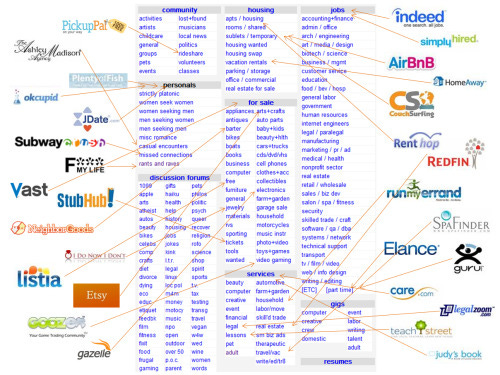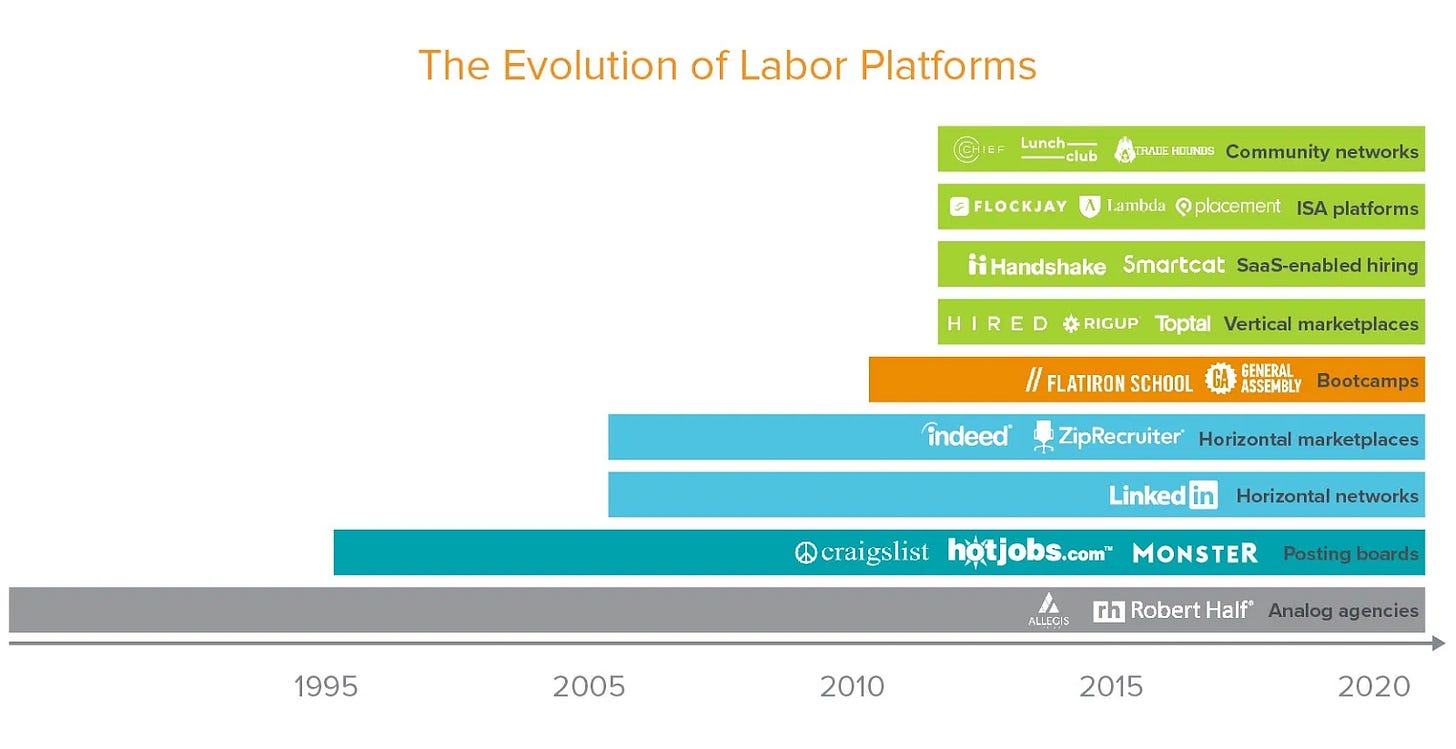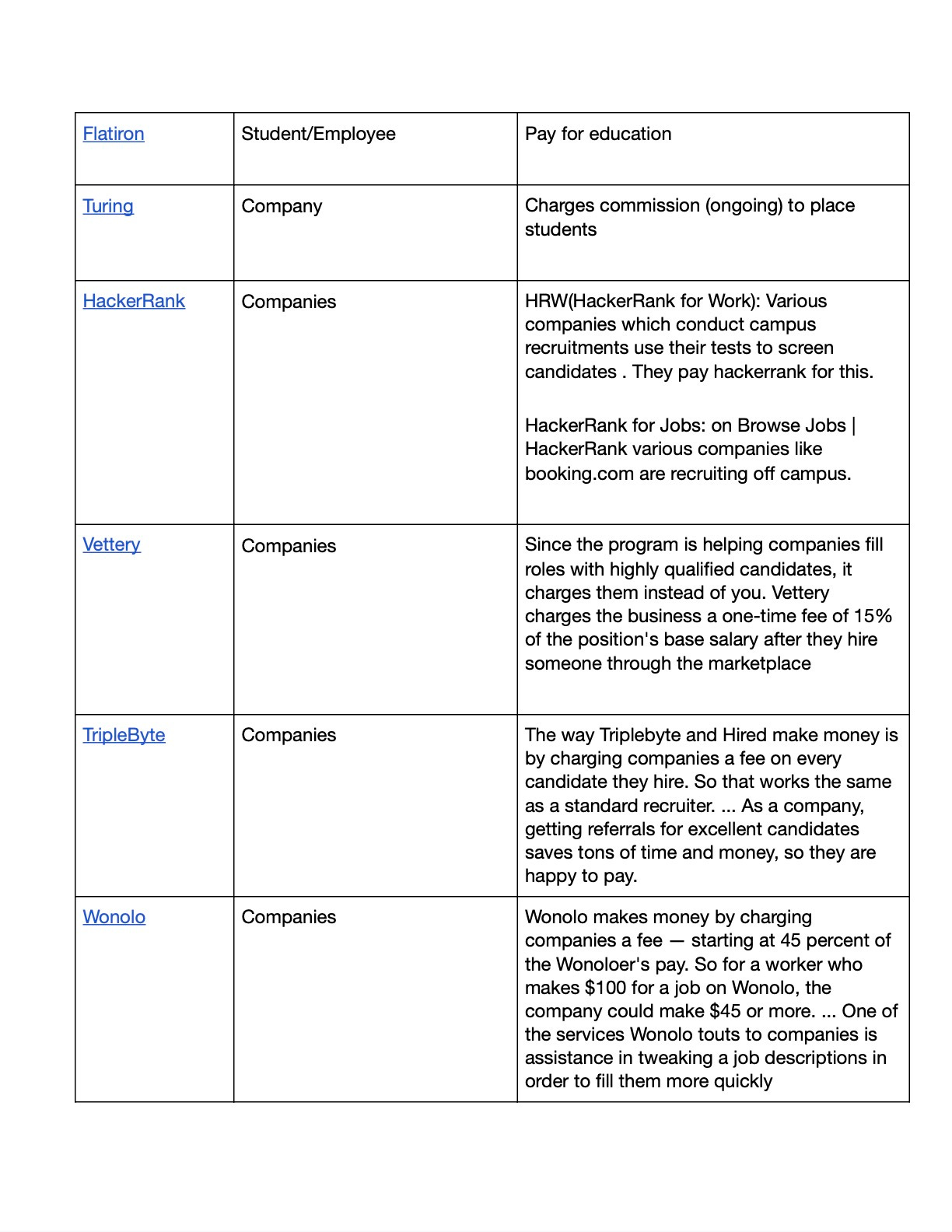Labor Markets : 2021 and Beyond
In this article I cover the history of labor markets, vertical and horizontal labor markets, WTA markets, functions of networks, market landscape today, monetization models, and labor market moats!
Hi All,
I hope you all are doing well and welcome (if you aren’t new then again) to Dozen Worthy Reads. A newsletter where I talk about the most interesting things about tech that I read the past couple of weeks or write about tech happenings. You can sign up here or just read on ….
The intent of this note is to explore how the jobs market has evolved over the course of the last decade with a host of startups “craigslisting” Linkedin, Indeed, and all other job boards. Settle in this is a LONG one …
Close to a decade ago we saw craigslist being unbundled and this now familiar picture reflects what happened with Craigslist:
Source : The Gong Show — The Spawn of craigslist Like most VCs that focus...
Of course as it turns out a lot of these products “died” primarily since such vertical marketplaces had several key issues:
From : A Crowded Space — The Rebundling of Craigslist
Death was not necessarily caused by verticalization of a subsection of an otherwise horizontal market but rather the fact that the frequency and size of such transactions made it an otherwise inferior market. There were not enough transactions or volume of transactions in order for the market to take hold, seed, add continuous value, or to wit, make money! Verticalized plays of the past did not add anything, incrementally in terms of the marketplace (tooling and componentization, price setting and such)
In labor markets specifically, this lead to groupedverticalization which has been the market for the past 15-20 years leading to HUGE winners such as Indeed, ZipRecruiter, Upwork. Shiftgig is interesting but not a winner, yet.
Vertical and Horizontal Markets
Vertical markets failed, back in the day, primarily because you needed either high frequency or high transaction size in order to make it work. At this point this is pretty much a moot point since a significant % of labor market now finds employment online and this is only increasing due to mobile proliferation, Millennials, Gen Y, Gen Z, Unbundled education, and of course COVID-19
From COVID-19 and the Great Rehiring, this is literally the most opportune time to create a market since there is a huge constituent of the workforce (around the world) that is unemployed and this is perhaps the right time to unbundle.
Clearly, these are not normal times. So we can’t rely on the “normal” tools we’ve previously used to help people find work: the LinkedIn and Craigslist searches, coffee chats, recruiters, staffing agencies, and so on. Those methods can’t hit the speed, scale, and placement quality that companies or candidates will need coming out of this crisis. But verticalized jobs marketplaces—platforms that focus on one industry, role, candidate type, or demographic—can and will. Now is the time to be building them.
The tools we currently have at our disposal—the horizontal jobs platforms like LinkedIn, Indeed, and Craigslist—are clearly inadequate for the enormity of the task. The average time to hire in 2018 was 38 days. Given the scale and urgency of the crisis, that’s far too long.
Too often, the existing online jobs platforms are a futile exercise in imprecise drop-down menus and trial-and-error search terms just to surface the jobs or candidates you’re interested in, let alone qualified for. These platforms feel like one of those all-encompassing, cross-cuisine diners with a 17 page menu: they offer a broad look at everything you might want, but don’t do any one thing particularly well. They require too much work to separate the signal from the noise, which impacts both the speed and quality of the process. It’s the classic story of a horizontal platform reaching its inevitable breaking point.
And while the typical analog avenues—networking, an endless string of “catch-up coffees,” working with a placement agency—might suffice in a regular economy, they can’t hit the scale or speed needed to meet the challenge now ahead of us. And the most efficient channels for doing so, like internal hires and recruiters, are difficult to scale.
Network theory has a concept called chicken-and-the-egg problem, which essentially means which side of the network can you “mobilize” fast/first in order to make the other side of the marketplace attractive. Essentially, the argument is that given the number of unemployed people today, building a vertical network has both the largest chance of success as well as the significant number of participants. This is not necessarily only true of jobs that have been lost but COVID is reshaping work and a significant % of the “elite” workforce is also rethinking their “job”. In short the best time to go to market is NOW since bootstrapping a network has never been this easy (Entire read is worth it)
This does not mean that one starts a company without thinking about the following:
Friction to Value
What friction are you removing? What value is created and who will be willing to pay for that value. Think of a company such as TripleByte, they add value by pre-interviewing candidates for a 1st round and narrowing the funnel. They do this with quizzes that standardize and rank and “surface up” the best candidates
Tool to Value
What kind of tool can you create that people can use and once they find value use the jobs section? Take Blind for example. No one comes for a job, they come to ask questions about a job or company and stay for the network
Create supply
One of the ways to solve this problem is similar to what Lambda School and Flockjay are doing. They are creating the “supply” and “supplying” highly qualified in-demand candidates to companies and arbitraging on income (ISA’s, though that is rife with issues as is expected in a new market)
Network → Jobs
The starting point is some kind of community or information. Lunchclub for example brings together tech professionals to start with. Once there is critical mass, they can layer in jobs, referrals and such. Blind in some ways already does this with the “can you refer me to x”. And of course this guy below wants to work everywhere!
In the jobs world, the “transaction” was matching. Everything else had to be done by the jobseeker/company. As 'Deep' Job Platforms and How to Build Them shows:
The key point in this story in almost all cases the broad horizontal verticals eventually break creating a path to “bundle” not just job matching but other key components into the platform there doing three things:
Smoothening the experience for a subset of that broad “horizontal vertical”
Extracting a larger sum of money from that market segment. The money was going to be spent anyway!
Strengthening or building moats. An example here might be why people don’t “leave” Upwork and go off platform. This is an example of a cross side negative network effect whereby either side has the trust of the company and does not want to leave. The risk of going off platform is so much deeper than the savings from going “off platform” that either party to the transaction does not do this
The other key points here are that users get tired of a generic experience built to suit “all” use cases and sub products emerge. A good example to explain this would be a Linkedin Profile. Your profile has several sections but it doesn’t differentiate if you are Nurse or a Truck driver. It doesn’t differentiate if you are VP or an Associate Software Engineer. Quite suddenly there is a large market that can now use a differentiated product. Demand for differentiated platform functionality is an outcome of a market where the conditions for Winner Take All do not exist ...
WTA Markets
Winner Take All Markets - A quick definition. Winner take all markets essentially try to answer some key questions about a market to determine if there is a winner.
Is the market a natural monopoly?
Are there strong same or cross side network effects?
Are there high switching costs? For which side?
Is there demand for differentiated platform functionality?
Are there high multi-homing costs?
Jobs markets are not at all WTA markets. They are obviously not natural monopolies, there are strong positive cross side network effects, there is demand for differentiated platform functionality, and the costs to multi-home while increasing are not prohibitive.
This is playing out today for the jobs space overall ….a16z – “Platforms vs Verticals and the Next Great Unbundling”
One of the most attractive “platform” targets we see today, only just starting to be chipped away at, is LinkedIn. Take a look at LinkedIn’s revenue from 2009-2016. At the time of LinkedIn’s June 2016 sale to Microsoft for $26.2 billion, their quarterly revenue of the time of sale was ~$1B.
Horizontal players essentially offer the same “user experience”, the same jobs data and such. LinkedIn has worked great for white collar jobs but more specialized verticals such as blue collar workers, nurses, engineers are not well served by LinkedIn’s (as mentioned above) vanilla offering. In the past, there was a gap in the market, but never a market in the gap -- that's the key change today.
The job market is already seeing some of this play out, some parts successfully and some unsuccessfully … Hired (now acquired by Vettery), Blue Collar/Hourly (Wonolo), Industry Play (WorkRise), Food Service (Pared) and many such examples of markets not served well by LinkedIn have started to unbundle.
Functions of Networks
Networks serve several key purposes:
Connectivity
Connectivity is nothing but creating the platform that allows both sides to participate in a networked transaction. Take for example, craigslist, it “connected” you to others but that was it.
Variety
Variety is generally a good principle to follow especially for a n-sided MP. Variety can display a variety of network effects and characteristics. For example in a 2SMP such as Uber, there is a positive cross side network effect of “more passengers means more drivers” but there is also a negative same side network effect of “more passengers means more competition”. This same side negative externality was removed with increasing drivers and surge pricing. In a job setting the externality of “too many applications” can be removed with filters/preventing the seeker from applying which no one does.
Matching & Discovery
Tools to match and discover new products. In the jobs scenario this could be things like recommended jobs, job alerts, but those are weak signals today. Skills matching, coding tests, deeper vetting are newer emerging techniques to improve “matching” and “discovery on both sides of the marketplace
Price Setting
Some platforms offer price setting in the jobs context (Upwork is a great example) where both as a job seeker as well as a company when you post a job/apply for a job it asks you what “price” you want to set/accept for a gig. There are of course new products such as levels.fyi and Blind that round out the “disinformation”. In some ways Blind is a good example of “come for the tool, stay for the network”.
Tooling and componentization
Proving tooling or components within this journey that alleviate an (generally negative) externality are being built today that alleviate concerns. For example Upwork Plus promises to “cut your hiring time in half”
Landscape of Labor Markets in 2021
Verticalized labor marketplaces are jobs platforms designed for a unique use case. Some examples are below, however the categories are not, in my opinion, complete.
What are the different categories that jobs can be divided into? Do note that these are N-sided marketplaces. Jobs is at least a 2SMP and I’ve indicated below who was the primary target market (most of them are geared towards jobseekers)
Monetization Models:
Defensibility
There are eight ways to create a defensible moat and I think what is going to happen is the moats are going to change. Moats that were great in the labor markets of the 90’s and 2000’s will start to break down and new moats will get created. Or it could well be that the way the moat exists today will get reshaped/exist in a different way. Let's take a look
Economies of Scale
The premise of economies of scale is quite simple. The scale allows them to, for example, price products cheaper as they can make it up on volume. I think this moat exists in certain job focused companies such as Indeed and Craigslist. They have lots of traffic, a good SEO game, and they have a jobs presence in so many countries that makes it hard for any local competitor to enter the market. In the future I think this moat will cease to exist/become less valuable for Indeed. New companies will not necessarily need to create a moat around scale as other moats are easier/better
Economies of Scope
I think LNKD is the poster child of this. They tie all pieces of the professional social network together. I can’t imagine a future competitor trying to become a LNKD and LNKD will continue to exist. LNKD themselves might start getting into more areas of the market similar to their recent announcement (or rumor) of them getting into the freelancer marketplace.
Network effects
Network effects will continue to play a huge role as labor markets continue to get disintermediated. Cross side network effects continue to remain important. Though I really wonder if negative same side network effects will remain the same or become worse for certain types of labor markets such as remote jobs portals as you now compete with more people
Counter positioning
I think some of this is happening today but in an indirect way; if you think about Lambda School they do not make $ until the “student” gets a job that pays well enough. So they give you the education for free but use an ISA (Income Sharing Agreement) to recoup their costs
Switching costs
There are weaker switching costs today for the “labor” piece of things. Granted that companies like LinkedIn have some switching costs associated with their professional network. Upwork has some switching costs (ratings, payments, current clients etc). I think as more and more platforms become “deep job” platforms we’ll see more switching costs accumulate to participants on both sides of the market.
Brand
Brand has always been important in labor marketplaces and the winners are definitely larger brands such as Indeed, LNKD, Naukri (IN), Upwork etc what is going to happen is that this will become much more important for certain types of labor markets since they now do more than just connectivity
Cornered resource
This does not play a role today and I can’t see it playing a role in the future either. There are patents for certain aspects of the technology but I do not think that this matters as much
Distribution/Market presence
Distribution and market presence have been important to scale labor markets and I think this will continue to remain key in being able to expand labor markets especially when hiring across borders and taking part in a deeper way. I figure that the barriers that used to exist in the past - payments, legal, etc - are easier to figure out today and once a company figures out a specific market and what works the rest should be easy -- to be clear I am not saying that the same playbook will work in all markets.
Conclusion
There is a lot of conversation today about the Passion Economy and for good reason. The labor contract that we’re used to. Fixed wages for a fixed number of hours in a fixed location is starting to get turned on its head -- the pandemic, dissatisfaction among workers, shrinking global boundaries, expensive education (at least in the US). Labor markets have been been “sleepy town” for the past decade. I expect that we will see a LOT of activity, funding, and new business models in the next decade or two. It almost feels like labor markets are going to have their Web 3.0 moment!
Thank you for reading. Stay safe, be well! If you enjoyed reading this please consider sharing with a friend or two (or sign up here if you came across this or were forwarded this)


















